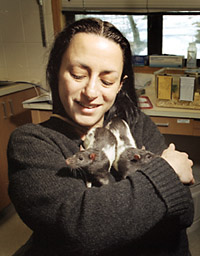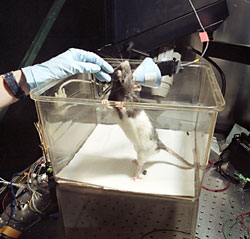|
|
|
Model
Organisms
|

|
Because rats
and mice are mammals, they share more genes with humans than some
other popular model organisms and can be used to study common mammalian
physiology as well as human disease. The mouse is used extensively
for biomedical research, and was the first mammal to have its genome
completely sequenced. In the early 1900s, cancer researchers at
Cold Spring Harbor developed the mouse strain (called C57-Black)
whose genome was sequenced. Today, dozens of mouse variants are
commercially available for studying human disease from places like
Jackson
Laboratory
in Bar Harbor, Maine.
Compared with mammals such as dogs and apes, rodents are small and
inexpensive to raise, have a short generation time, and are relatively
easy to work with.
 On
comparing the genomes of humans, mice, and other organisms:
On
comparing the genomes of humans, mice, and other organisms:
"Every scientist would love to take a genome and figure out
what every single letter of the genome is doing. And the way you
could do that in theory is experimentally change each letter. You
could do it in cell culture and see what effect that had . . . but
my goodness, what a tedious, expensive, and slow process.
"It turns out, that’s what evolution does everyday. Every
morning, evolution makes mutations here and there, new organisms
arise in a species with a few changes here, a few changes there,
and natural selection decides whether this was a good idea or not,
whether you’ve disrupted an essential function or perhaps created
a new function that’s valuable.
"If we look at the human sequence and the mouse sequence, which
descend from a common ancestor maybe seventy-five million years
ago, and ask what’s been preserved, what’s been preserved,
better than chance, must be the things that matter. You can regard
genomes as the laboratory notebook of evolution over seventy-five
million years. We’ve got records, in the form of DNA, of all
the evolutionary experiments on this planet. What we have to do
is become really thoughtful, sensitive readers of [those records]."
—
Eric
Lander
, Director, Whitehead Institute's Center for Genome Research
 On
rats as model organisms for studying the brain:
On
rats as model organisms for studying the brain:
"Rats
are good model organisms because, as mammals, they’re close
to humans but not too close. There's a compromise between what you
can do ethically in an organism and the organism being evolutionarily
close to humans. You cannot study decisions in a worm and you cannot
ask a person to open up his or her head and examine the brain with
electrophysiological tools. The kinds of questions we are asking
are currently studied mainly in monkeys, but we believe rats will
be just as useful. So we get a level of analysis that is only possible
in humans very rarely, such as the case of a patient having surgery
for epilepsy. In humans, we usually get a much coarser view of the
brain than we get with rats."
On comparing rats and humans:
"Our ignorance of the neurological basis of human behavior
is extreme. If someone is diagnosed with schizophrenia, they're
treated with a drug whose mechanism of action we barely understand.
Although in some cases it makes the person a little bit better,
we really don't know why mechanistically that happens. Human decision-making
and human behavior seem very far from rat behavior, but these drugs
that we use to treat schizophrenia or depression or attention deficit
disorder mostly are acting on neurotransmitter systems that are,
as far as we understand them, the same in rats and humans."
—
Zachary
Mainen
, Research biologist, Cold Spring Harbor Laboratory at
MIT
|
|


 On
comparing the genomes of humans, mice, and other organisms:
On
comparing the genomes of humans, mice, and other organisms:
 On
rats as model organisms for studying the brain:
On
rats as model organisms for studying the brain: